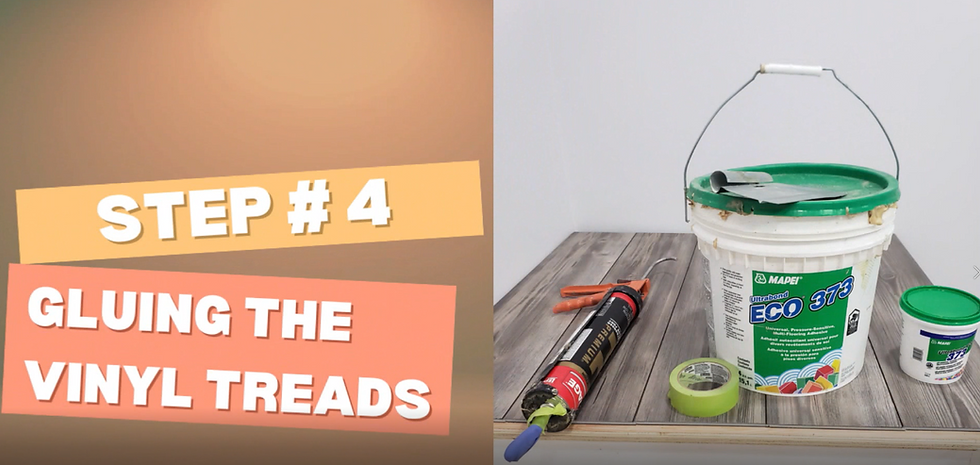STEP 2: Measuring and Making Templates for Vinyl Stair Installation
- Lana. Vinyl Nosing Specialist

- Dec 17, 2024
- 3 min read
Updated: Dec 28, 2024
These videos are separate parts of our comprehensive Vinyl Stairs Installation tutorial, designed to guide you through each step for your convenience. Watch them individually to focus on specific aspects of the process, or watch the entire video (🔥How To Install Vinyl Plank Flooring On Stairs🔥A Step-by-Step Guide) for a complete, step-by-step installation guide.
When installing vinyl stairs, precision is key to ensuring a smooth, professional finish. In this step, we’ll guide you through the process of measuring and making templates for vinyl stair installation, a crucial phase in the installation that will help you achieve a flawless result.
Tools You’ll Need:
Measuring tape or laser distance measurer
Miter saw or table saw (important for cutting nosings and treads)
Extra piece of nosing (to create templates)
Stair Step Scribe or plywood (for template creation)
1. Take Accurate Measurements
You can use any measurement tools you have available—whether it’s a simple measuring tape or a more advanced laser distance measurer. The goal is to gather precise data for the tread and riser sizes, as well as the angles.
2. Addressing Stair Angle Inconsistencies
One thing we’ve learned over time is that no staircase is perfectly straight. Most stairs have some degree of angle inconsistencies, which can make measuring and cutting challenging. But don’t worry—we’ll show you exactly how to handle these inconsistencies in this step.
3. Use Proper Tools for Cutting
It’s important to note that if you’re installing vinyl stairs, you should be proficient in using a miter saw or a table saw. These tools are necessary for precise cuts, especially when dealing with nosing and tread measurements. If you’re not comfortable using them, we strongly recommend hiring a professional installer. Be sure to show them this video for reference.
4. Cutting the Nosing Return
The first part of the process is to cut the nosing return to match the depth of your bullnose. To make this cut, use an extra piece of nosing as a template before cutting the actual purchased nosings. It's important to leave a small gap (about 1/8" or 1/16") for glue, ensuring the pieces fit snugly when attached.
5. Measure and Make the Tread Template
Once the nosing is cut, move on to measuring the second part of the tread for depth or width. This measurement will help you create a template for the tread that matches your staircase's specific dimensions. Remember, tread lengths typically range from 32-36 inches, and there will usually be a 10-12 inch leftover piece from the nosing, as the nosings are made from full plank lengths. You can use these leftover pieces to practice your cuts before working with the final pieces.
6. Handle Stair Angle Inconsistencies
As we mentioned earlier, stair angles are often inconsistent, and tread depths can vary slightly from one step to another. Pay extra attention to your measurements and cuts, ensuring everything aligns properly as you move through the process. Precision here will make the final product much more professional.
7. Connect Nosing and Tread Templates
Once you’ve created your nosing template, connect it to the second part of your tread template and test it on each step. This allows you to ensure everything fits as expected. It's important to test it on multiple steps since stair dimensions can slightly differ from one to the next.
8. Cut All Nosing Pieces
Use the nosing template to set up your saw for cutting the remaining nosings. Since each tread can differ, it’s important to double-check your measurements before making each cut.
9. Cut the Second Part of the Tread
Next, do the same for the second part of the tread. If your tread depths differ, the second part of the tread will vary in width as well. By using your template, you can ensure consistent cuts for each step.
10. Measure Tread Width at Nosing and Riser
For the final measuring step, measure the tread width at the nosing and riser. Keep in mind that there could be a difference of about 1/8" between the measurements, so be sure to take this into account when making cuts.
11. Using a Stair Step Scribe or Plywood Template
To create a template for each step, you can use a Stair Step Scribe tool or even create a custom template using plywood. The scribe tool is helpful for tracing the exact shape of the stairs, while a plywood template can be a more durable solution for multiple cuts.
By following these steps carefully, you’ll be well on your way to completing your vinyl stair installation. Remember, the key to a successful project lies in your precision—take your time with the measurements and cuts, and you’ll achieve a professional-looking result that you can be proud of! Stay tuned for the next step in our series on installing vinyl stairs.
Stay tuned with @VINYLNOSING for the next part of our tutorial, where we’ll guide you through the installation process of vinyl planks on your stairs!
.png)



Comments